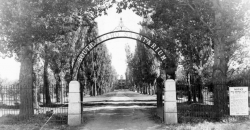The History of State Hospital South
This Halloween, take a closer look at the spookiest place in Blackfoot!

Of the many spooky locations around Blackfoot, State Hospital South is the most widely known and feared. The large building is ominous-looking all by itself, but the stories of the permanent residents within are even more terrifying. Dangerous experiments, animal-like treatment and hauntings are just a few of the many horrors that lie within the old building.
When the “Idaho Insane Asylum” was first opened on July 2, 1886, the patients were referred to as “inmates”. At that time, there were 36 inmates, 26 men and 10 women, who had previously found residence at an asylum in Oregon. The inmates were not only given treatment, but also worked on the asylum’s farms.
Today, State Hospital South consists of units. There is an adolescent unit that is composed of 16 beds, which is designed for patients age 11-17, three adult units for those over 18 and the Syringa Chalet Nursing Facility, which caters to individuals over 65.
“They also have tunnels underneath [the building] that they use to transport patients with. Well, what they don’t tell you is that there are also rooms down there that they use to do experiments with. One room was a water boarding room. They would either stick a towel over the person’s face and dump water on it or put their face in a bathtub. They were trying to get rid of the evil spirits,” Noelle Rasmussen, who has visited the tunnels, said. “We went in there on Halloween night. We had a guide that worked there, and while we were down there, we could absolutely feel a presence. We also heard tapping on the pipes that we were told was from the ghosts of deceased patients.”
The true terror of the mysterious building sparks from the patients within and the shocking stories that stem around their conditions.
In 1966, Terry Bateman, a psychology major, visited State Hospital South as part of a class field trip. He remembers seeing “a person in a strait jacket to protect her from harming herself and the general population.” He also saw adults talking to invisible people, but the patient that Bateman remembers most was a 20-year-old male patient.
“He was a big strong man who was extremely violent and was exercised by two large employees, one on each side of him with a leash attached to his neck. He was run to reduce his aggressive behavior. He tore the sink and toilet off their mounts and defecated in his food tray and smeared fecal matter all over the walls and himself,” Bateman said. “Imagine cleaning up that mess. They had to use a garden hose on him and his cell. That’s when I decided not to be a clinical psychologist.”



William Shane Mettz • Jul 17, 2021 at 6:13 pm
Can you take tours of the tunnels at the State Hospital South?
A • Oct 2, 2023 at 2:16 pm
No- they no longer in use. They have all been sealed off d/t safety.